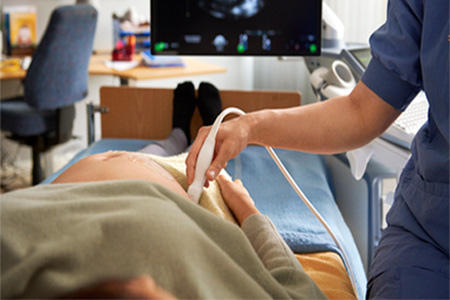Flying and travel while pregnant
Travel during pregnancy is generally fine – but a growing belly can make the trip a bit more uncomfortable and cumbersome. So it’s wise to plan your trip well and be aware of safety guidelines, like where your seatbelt should sit when you’re pregnant, or how late into pregnancy you can actually fly.
Thinking about a babymoon before the arrival of your little one? As long as you’re feeling fine and you’re not too close to your due date, a pre-baby trip can be a great way to get energized. We’ve gathered some tips and advice here on what to keep in mind before and during your trip.
Seatbelt and car safety while pregnant
It’s easy to put on your seatbelt – we do it habitually and more or less on autopilot. But when you’re pregnant, it’s important to position the belt in a special way that protects both mother and baby. People often put the belt in the wrong place – and that can have extremely serious consequences in the worst-case scenario. The most common mistake is to place the belt diagonally across the belly, as we do when not pregnant. But to avoid putting pressure on the belly in the event of a collision or sudden strong braking, the lap belt should sit below the belly, down towards the thighs. The diagonal sash belt should be positioned between the breasts and to the side of the belly. The seatbelt should not slide out over the shoulder; make sure it is securely in place. It is also good to know that maternity seatbelts on the market enhance comfort during travel, but are ineffective when it comes to safety, according to the Swedish National Society for Road Safety.
The airbag helps distribute force and together with the seatbelt, it can also protect the belly. But remember not to sit too close to an airbag. This is also true if you are driving: maintain a distance of about 20–25 cm between your belly and the steering wheel. It’s also best to avoid driving long distances while pregnant, because the usual discomforts associated with this time, like fatigue and nausea, might impair your ability to concentrate. Sometimes, it might also be a bit of a struggle to sit still for long periods of time, so if you’re not the only one with a license, it’s best to switch drivers regularly.
Tips for long trips while pregnant
- Long trips can be particularly uncomfortable when you’re pregnant. What you need depends a bit on your mode of travel, of course, but here are some tips for longer trips.
- If you can, skip the plane and travel by train instead – not only is it better for the environment, you will also have more room to move around and it can be a comfier way to travel while pregnant in general.
- Travel early in your pregnancy, if possible. It’s wise to go during your first or second trimester. After that, things may feel a bit cumbersome and your body will have more needs, which can make it tougher to enjoy your trip.
- Trains and planes generally have aisles where you can move around, so take the chance to stretch your legs, because sitting still can often be a bother for your back. Spending a lot of time sitting still also increases the risk of blood clots.
- Try to reserve an aisle seat to have more space and to make it easier to get up and back in.
- On long car trips, plan for frequent breaks.
- Drink plenty of water, especially if you’re travelling by plane, because the air is drier and it’s easy to become dehydrated.
How late into pregnancy can you fly?
Different airlines tend to have different rules regarding how late you can fly when you’re pregnant, so it’s best to contact your airline and ask. For example, it might be the case that you can only fly up to a certain number of weeks before you’re due, and you might need additional approval from the airline after that point. If you’re expecting twins, special conditions may also apply for flying. The rules are in place to avoid making an emergency landing if you go into labour, rather than because of any danger to mother and baby.
Clever items to pack when pregnant
It depends where you’re going, but here are some suggestions for items it might be good to bring along.
- Saline eye drops to avoid dry mucous membranes.
- Bug spray that is pregnancy-safe. Read the package or ask at the pharmacy.
- Sunscreen and a sun hat if you’re off to warmer climes. Be mindful, because it’s easier to develop pigmentation while pregnant.
- Pregnancy-safe medicine for constipation.
- Compression socks (but talk to your midwife or doctor first, because with some medical conditions, compression socks are contraindicated).
- Pain relievers that are safe during pregnancy.
- Medicine for indigestion.
- Fluid replacement.
- Yeast infection treatment. You’re a bit more susceptible while pregnant, and in warmer countries especially, you’re at higher risk of getting a yeast infection.
- Nasal spray if you plan to fly – but make sure to choose one you can use while pregnant.
- Nursing pads for your bra if it is later in your pregnancy and your breasts are leaking.
- Hand sanitiser and wet wipes, so that you can clean your hands even if you don’t have access to soap and water.
- Earplugs and an eye mask.
- Walking shoes and comfy clothes.
Travel insurance and vaccines for pregnant travellers abroad
Before you go abroad, it is especially important to find out what applies should you need medical attention related to your pregnancy while on your trip.
- Home insurance does not usually cover medical costs related to pregnancy after week 28. If your baby is born early and needs care abroad or transport home, you may have to cover the cost yourself. But these conditions might vary, so contact your insurance company to learn more and whether you need additional insurance for pregnancy.
- In some countries, you might need an EU card that entitles you to medical care in that country. If you live in the Nordic region, you won’t need anything, because the Nordic countries have an agreement that covers additional fees for travelling home. You can google where to order an EU card in your country (provided that you live in the EU).
- If you live in Sweden, that country has medical care agreements with several other countries. Find out what applies through the Swedish Social Insurance Agency.
- Don’t forget to check which vaccines you need if you’re travelling abroad – and make sure it’s okay to take them while pregnant.
- It might be a good idea to bring a copy of your medical record on your trip, which contains important information about your pregnancy that might be relevant if you need medical attention. A certificate of pregnancy might also be helpful, in case your travel agency or the clinic where you are going needs certification of how far into pregnancy you are.
Avoid infection while travelling abroad
If you’re planning a trip to a country with a higher risk of various diseases, it’s worth considering whether to postpone until another time. If you’re pregnant or planning to become pregnant, do not travel to countries where you would be at risk of catching the Zika virus, which can cause foetal abnormalities. Check your country’s health agency for up-to-date information on which areas to avoid. You can also talk to your doctor or midwife if you need advice before your trip.
Other golden rules to remember are: wash your hands often, drink bottled water, and eat well-cooked food. Getting food poisoning while pregnant would be particularly unenjoyable.
Please note that all information above is based on Swedish recommendations.


